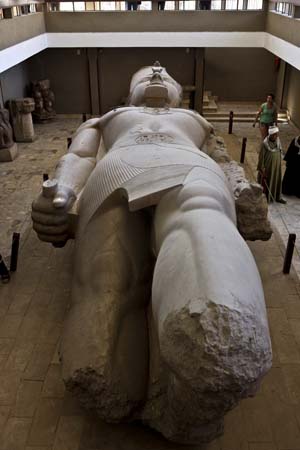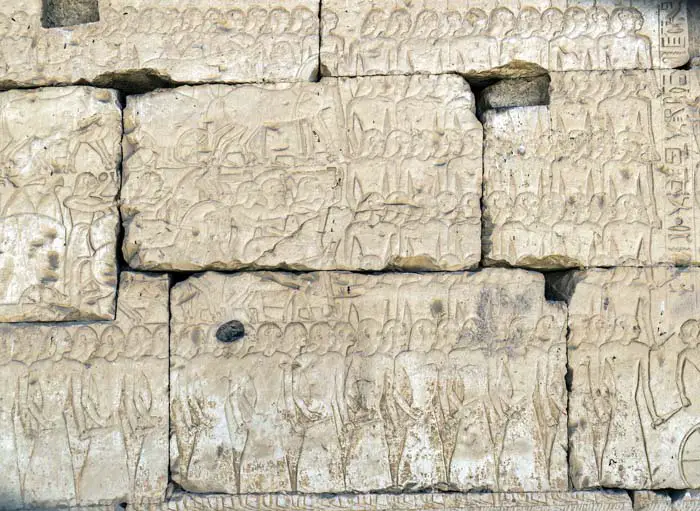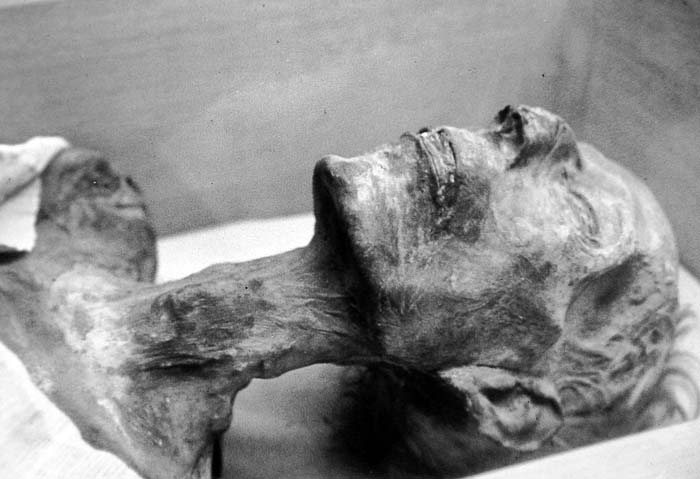Pi-Ramses, an ancient city in the Nile delta, was established by Ramses 2 and used for his campaigns in Syria. This city is mentioned in the Bible, as a place where Israelites were forced to work for the Pharaoh.
Another ancient city, Abydos (known for its mythological inscriptions) was used by Ramses II to record the history of his reign and that of his ancestors, providing a wealth of knowledge for future generations on the accomplishments of these pharaohs.
 © Cliff Hellis – Ramses II, Memphis
© Cliff Hellis – Ramses II, Memphis
The well known Ramses II statue unearthed at Memphis was thought to have been commissioned by Ramses II himself. It has shown people today how large of an impact Ramses the Great had on the artwork of his day. Other sites have yielded similar large Ramses II statues.
Ramses II: Military Impact
The reign of Ramses 2 was marked by numerous military battles and he became one of the famous Egyptian pharaohs known for his military strength. Much of his reign was occupied with taking back territories that were lost to Egypt during the rule of other ancient Egyptian pharaohs (most notably Akhenaten) was preoccupied with establishing a monotheistic religion. Ramses II’s army was 100,000 men strong, enormous for that period in time.
Ramses 2’s most famous battle is the Battle of Kadesh, which took place at the city of Kadesh (situated in present day Syria). Fought in 1274 BC against the Hittites, it was the largest chariot battle ever. Ramesses made a tactical error in that fight by dividing his forces, causing one of his divisions to be swept away. Eventually none of the parties gained victory and Ramesses had to retreat because of logistic difficulties.
The military genius of Ramses II helped to secure Egypt’s borders from foreign invaders and pirates along the Mediterranean and in Libya. He managed to fend off invasions from the Hittites and Nubians.
In addition, his campaigns restored land to Egypt that had been previously lost to these empires. By forming peace treaties with these empires after warring with them, Ramses II helped to solidify Egypt’s borders on all sides, allowing for increased internal stability. Many of these campaigns were completed in the first twenty years of Ramses II’s reign.
 © kairoinfo4u – Scenes from the battle of Kadesh in Syria
© kairoinfo4u – Scenes from the battle of Kadesh in Syria
Ramses II’s Religious Impact
The religious impact that Ramses 2 had on Egypt is not to be overlooked either. After reigning for thirty years, Ramses II celebrated the Sed festival, in which the king was turned into a God.
Ramses II defaced the monuments of previous reigning dynasties which had fallen out of favor, and sought to return Egyptian religion to how it had been before the reign of Akhenaton.
Since the people of Egypt worshiped Ramses II as a god, it also helped to ensure that his son, who at that point commanded the army, would rise to power following his death, without anyone trying to seize the throne.
Ramses and Moses
A much debated issue of religion and history alike is the Exodus. Known as the departure of the Israelites from Egypt, this event is considered to have happened under the reign of Ramses II. Whether or not it did happen as the story tells us, scientists found evidence for the existence of the notorious ten plagues of Egypt (or at least the first nine of them). The events do show a link to the capital city of Pi-Ramses and the grueling period Egypt crossed under the rule of Ramses II.
Click here to read more about Ramses and the plagues…
Ramses II’s Mummy
Ramses II was buried in the Valley of Kings, but had to be replaced because of looting. After a detour, his mummy was moved to tomb DB320, located near Deir el-Bahri, where it would be safe from tomb robbers. In 1881 his body was discovered there and moved to Cairo’s Egyptian Museum.
The mummy learns us Ramses II was rather short for an ancient Egyptian: 5ft7 (170cm). It also shows us his hooked nose and wounds and fractures incurred in battle.
In 1974 the mummy was transported to Paris because it needed treatment for a fungal infection.
















































